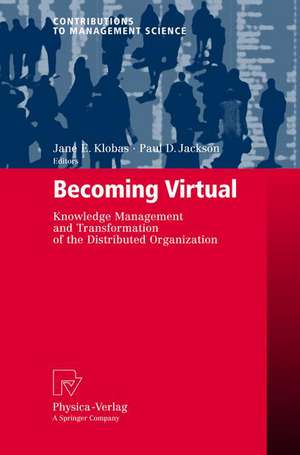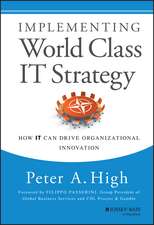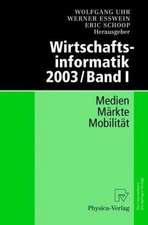Becoming Virtual: Knowledge Management and Transformation of the Distributed Organization: Contributions to Management Science
Editat de Jane E. Klobas, Paul D. Jacksonen Limba Engleză Paperback – oct 2007
Din seria Contributions to Management Science
- 18%
 Preț: 727.18 lei
Preț: 727.18 lei - 20%
 Preț: 565.28 lei
Preț: 565.28 lei - 24%
 Preț: 746.28 lei
Preț: 746.28 lei - 24%
 Preț: 829.10 lei
Preț: 829.10 lei - 18%
 Preț: 1113.09 lei
Preț: 1113.09 lei -
 Preț: 359.99 lei
Preț: 359.99 lei - 20%
 Preț: 875.44 lei
Preț: 875.44 lei - 20%
 Preț: 753.39 lei
Preț: 753.39 lei - 20%
 Preț: 938.85 lei
Preț: 938.85 lei - 24%
 Preț: 847.68 lei
Preț: 847.68 lei - 15%
 Preț: 697.82 lei
Preț: 697.82 lei -
 Preț: 282.19 lei
Preț: 282.19 lei - 15%
 Preț: 694.04 lei
Preț: 694.04 lei - 18%
 Preț: 913.44 lei
Preț: 913.44 lei - 24%
 Preț: 691.05 lei
Preț: 691.05 lei - 18%
 Preț: 952.89 lei
Preț: 952.89 lei - 18%
 Preț: 948.47 lei
Preț: 948.47 lei - 15%
 Preț: 585.69 lei
Preț: 585.69 lei - 18%
 Preț: 949.23 lei
Preț: 949.23 lei - 18%
 Preț: 957.62 lei
Preț: 957.62 lei -
 Preț: 384.86 lei
Preț: 384.86 lei - 15%
 Preț: 653.65 lei
Preț: 653.65 lei - 15%
 Preț: 646.43 lei
Preț: 646.43 lei -
 Preț: 379.86 lei
Preț: 379.86 lei - 18%
 Preț: 952.26 lei
Preț: 952.26 lei - 15%
 Preț: 644.82 lei
Preț: 644.82 lei - 18%
 Preț: 1836.01 lei
Preț: 1836.01 lei - 15%
 Preț: 642.68 lei
Preț: 642.68 lei - 15%
 Preț: 644.95 lei
Preț: 644.95 lei - 15%
 Preț: 643.48 lei
Preț: 643.48 lei - 15%
 Preț: 648.74 lei
Preț: 648.74 lei - 18%
 Preț: 948.29 lei
Preț: 948.29 lei -
 Preț: 381.43 lei
Preț: 381.43 lei - 15%
 Preț: 640.06 lei
Preț: 640.06 lei - 15%
 Preț: 638.24 lei
Preț: 638.24 lei - 18%
 Preț: 956.33 lei
Preț: 956.33 lei - 18%
 Preț: 1390.26 lei
Preț: 1390.26 lei -
 Preț: 386.22 lei
Preț: 386.22 lei - 15%
 Preț: 647.40 lei
Preț: 647.40 lei -
 Preț: 387.58 lei
Preț: 387.58 lei - 15%
 Preț: 646.11 lei
Preț: 646.11 lei - 15%
 Preț: 637.59 lei
Preț: 637.59 lei - 15%
 Preț: 645.60 lei
Preț: 645.60 lei - 20%
 Preț: 648.44 lei
Preț: 648.44 lei - 20%
 Preț: 325.95 lei
Preț: 325.95 lei - 15%
 Preț: 641.71 lei
Preț: 641.71 lei - 15%
 Preț: 640.06 lei
Preț: 640.06 lei - 18%
 Preț: 948.92 lei
Preț: 948.92 lei
Preț: 943.88 lei
Preț vechi: 1151.07 lei
-18% Nou
Puncte Express: 1416
Preț estimativ în valută:
180.62€ • 193.14$ • 150.59£
180.62€ • 193.14$ • 150.59£
Carte tipărită la comandă
Livrare economică 17 aprilie-01 mai
Preluare comenzi: 021 569.72.76
Specificații
ISBN-13: 9783790819571
ISBN-10: 3790819573
Pagini: 284
Ilustrații: XII, 267 p. 25 illus.
Dimensiuni: 155 x 235 x 18 mm
Greutate: 0.4 kg
Ediția:2008
Editura: Physica-Verlag HD
Colecția Physica
Seria Contributions to Management Science
Locul publicării:Heidelberg, Germany
ISBN-10: 3790819573
Pagini: 284
Ilustrații: XII, 267 p. 25 illus.
Dimensiuni: 155 x 235 x 18 mm
Greutate: 0.4 kg
Ediția:2008
Editura: Physica-Verlag HD
Colecția Physica
Seria Contributions to Management Science
Locul publicării:Heidelberg, Germany
Public țintă
ResearchCuprins
Envisioning and Planning for Virtualization.- Aligning Goals, Virtuality and Capability: A Virtual Alignment Model.- Envisioning and Monitoring the Process of Becoming Virtual.- The Challenge of Becoming Virtual.- New Insights into Knowledge Management and Virtualization.- Social Uncertainty in Virtual Organizations: A Preliminary Ontology of the Constituent Elements.- When Communities of Practice Fail: Community Ties and Organizational Commitment.- An Exploratory Survey of the Structure and Components of Organizational Memory.- The Organization as a Transactive Memory System.- Adoption of Technologies for Virtual Work.- Monitoring, Control and the Performance of Virtual Work.- Understanding Virtualization.- The Challenge of Becoming Virtual, Part 2.- Reflections from the Frontline: The Journey of a Knowledge Manager.- The Forensics of a Challenged Initiative.- Tools and Capabilities for Becoming Virtual.
Textul de pe ultima copertă
This book examines the capabilities needed to transform a globally distributed organization into a virtual organization (an organization that exists and operates across time and distance with the support of global communications technologies such as the Internet). It introduces techniques for definition of goals for virtualization, for monitoring progress toward virtualization and for studying the impact of virtualization on social uncertainty, knowledge sharing and knowledge transfer, organizational memory, transactive memory, communities of practice and organizational commitment, power and control. These techniques are applied in an extended case study of a development aid organization's attempts to use knowledge management for virtualization over a two year period. The multidisciplinary team of authors examines virtualization from points of view ranging from the organizational to the technological to the sociological and psychological.
Caracteristici
Includes supplementary material: sn.pub/extras
















